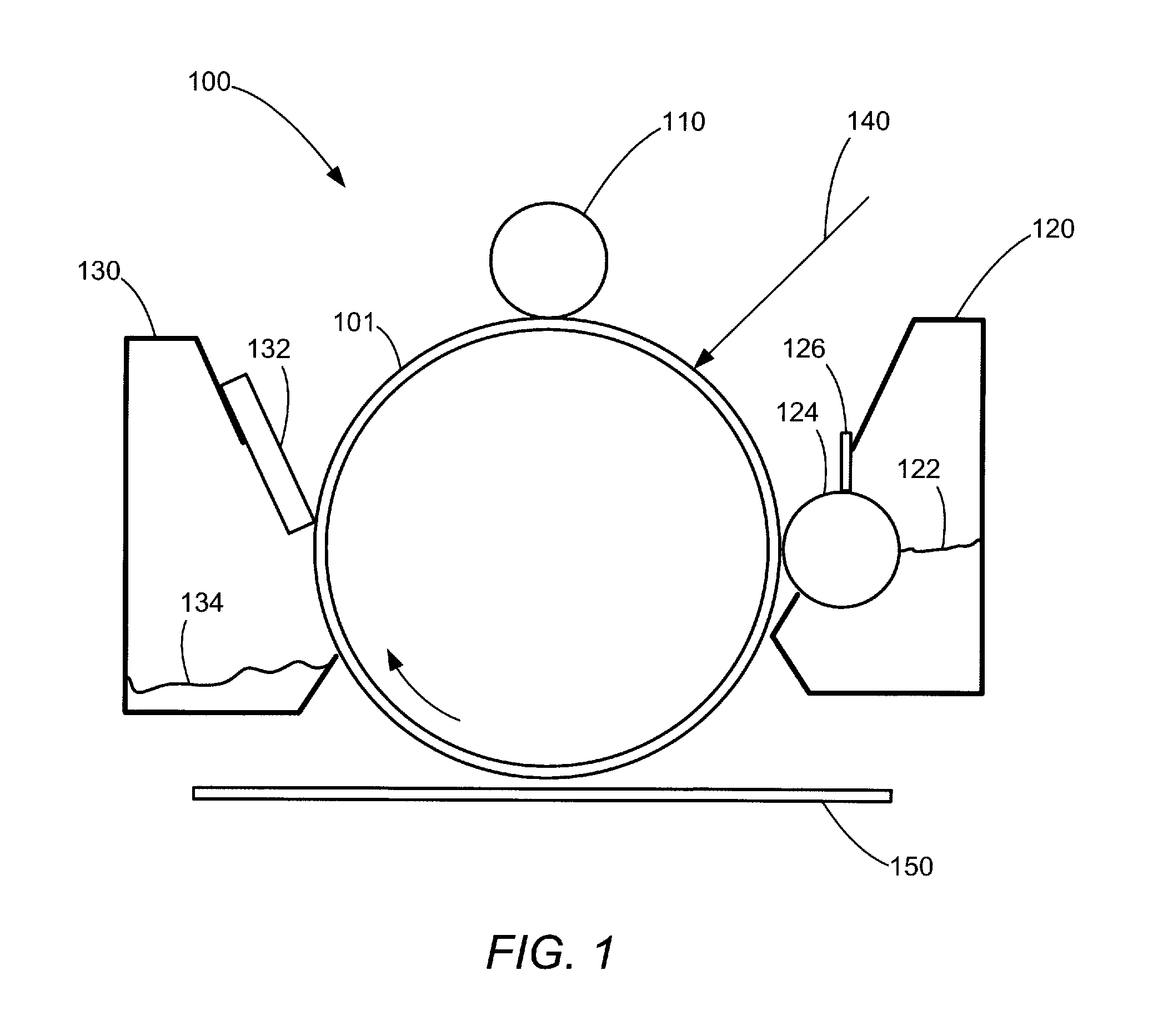Photo conductor overcoat comprising radical polymerizable charge transport molecules and hexa-functional urethane acrylates
a photoconductor and charge transport technology, applied in the field of photoconductor overcoat for organic photoconductor drums, can solve the problems of mechanical abrasion of the surface layer of the photoconductor drum, scratches and abrasions etc., and achieve the effect of improving the wear resistance of the organic photoconductor drum
- Summary
- Abstract
- Description
- Claims
- Application Information
AI Technical Summary
Benefits of technology
Problems solved by technology
Method used
Image
Examples
example 1
[0064]Photoconductor drums were formed using an aluminum substrate, a charge generation layer coated onto the aluminum substrate, and a charge transport layer coated on top of the charge generation layer.
[0065]The charge generation layer was prepared from a dispersion including type IV titanyl phthalocyanine, polyvinylbutyral, poly(methyl-phenyl)siloxane and polyhydroxystyrene at a weight ratio of 45:27.5:24.75:2.75 in a mixture of 2-butanone and cyclohexanone solvents. The polyvinylbutyral is available under the trade name BX-1 by Sekisui Chemical Co., Ltd. The charge generation dispersion was coated onto the aluminum substrate through dip coating and dried at 100° C. for 15 minutes to form the charge generation layer having a thickness of less than 1 μm, specifically a thickness of about 0.2 to about 0.3 μm.
[0066]The charge transport layer was prepared from a formulation including terphenyl diamine derivatives and polycarbonate at a weight ratio of 50:50 in a mixed solvent of THF ...
example 2
[0067]The overcoat layer was prepared from a formulation including 4,4′-di(acrylyloxypropyl)triphenylamine (2 g), EBECRYL 8301 (2 g) and methyl benzoylformate (MBF) photoinitiator (0.2 g) in a mixed solvent of isopropanol and THF. The weight ratio of isopropanol to THF in the mixed solvent was 90:10. The formulation was coated through dip coating on the outer surface of the photoconductor drum formed in Example 1. The coated layer was thermally cured at 60° C. for 5 minutes, then UV cured using Fusion UV H bulb for 5 seconds, and then thermally cured at 120° C. for 60 minutes. The cured layer forms the overcoat layer having a thickness of about 2.8 μm as measured by an eddy current tester. The overcoat thickness may be adjusted by either varying the amount of solvent, or changing the coat speed.
example 3
[0068]The overcoat layer was prepared from a formulation including 4,4′,4″-tri(acryloxypropyl)-triphenylamine (2 g), EBECRYL 8301 (2 g) and MBF photoinitiator (0.2 g) in a mixed solvent of isopropanol and THF. The weight ratio of isopropanol to THF in the mixed solvent was 90:10. The formulation was coated through dip coating on the outer surface of the photoconductor drum formed in Example 1. The coated layer was thermally cured at 60° C. for 10 minutes, then UV cured using Fusion UV H bulb for 5 seconds, and then thermally cured at 120° C. for 60 minutes. The cured layer forms the overcoat layer having a thickness of about 3.3 μm. as measured by an eddy current tester. The overcoat thickness may be adjusted by either varying the amount of solvent, or changing the coat speed.
PUM
| Property | Measurement | Unit |
|---|---|---|
| thickness | aaaaa | aaaaa |
| thickness | aaaaa | aaaaa |
| thickness | aaaaa | aaaaa |
Abstract
Description
Claims
Application Information
 Login to View More
Login to View More - R&D
- Intellectual Property
- Life Sciences
- Materials
- Tech Scout
- Unparalleled Data Quality
- Higher Quality Content
- 60% Fewer Hallucinations
Browse by: Latest US Patents, China's latest patents, Technical Efficacy Thesaurus, Application Domain, Technology Topic, Popular Technical Reports.
© 2025 PatSnap. All rights reserved.Legal|Privacy policy|Modern Slavery Act Transparency Statement|Sitemap|About US| Contact US: help@patsnap.com



